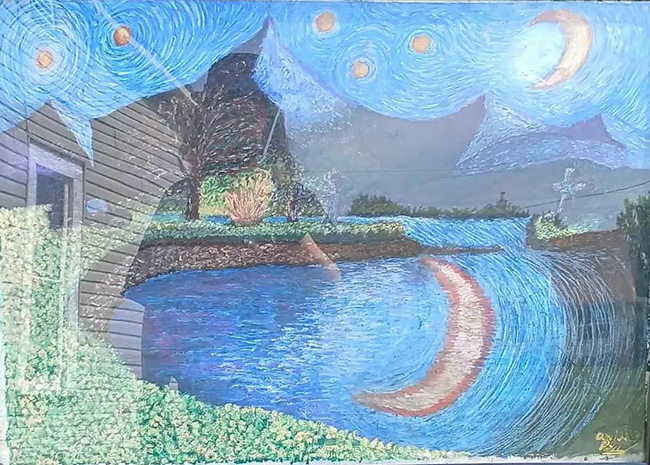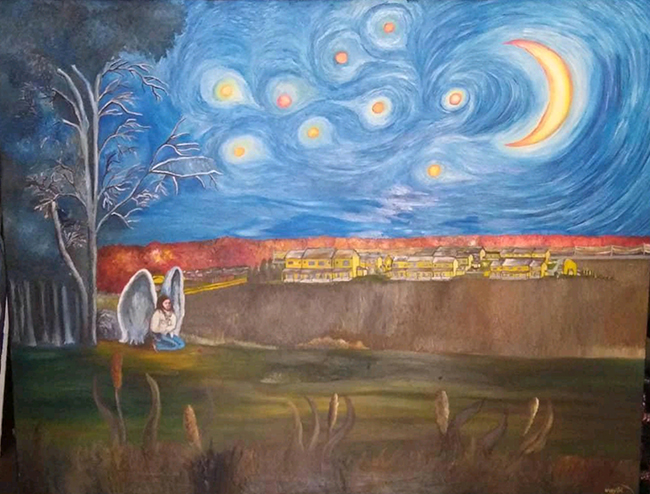David R.L. is a 29-year-old autistic artist, poet, and musician from Marshalltown, Iowa. For more than half his life—17 years—he has been immersed in the fine arts. His creative path has been marked by persistence and curiosity, always circling back to the need to express, to connect, to survive. He began at seven, sketching ancient Egyptian relics and simple still lifes, unaware that those first drawings would grow into a practice that now spans painting, poetry, and music. For him, creativity is not decoration or pastime—it is language. Sometimes it takes the shape of a line or a brushstroke, other times it is rhythm or silence. It is the thread tying his inner world to the one around him.
His work moves fluidly between realism, abstraction, and symbolism. Art history often meets memory in his compositions, giving them weight and texture. Whether he paints a sky full of stars, a pair of figures locked in intimacy, or an angel standing watch over a quiet field, the results feel urgent, layered, and unguarded. Each piece carries his particular way of seeing, unafraid to let vulnerability show.

In one painting, David revisits Van Gogh’s Starry Night, yet the result is not mimicry—it is translation. A river winds through the scene beneath a restless sky, with a crescent moon glowing above and echoing in the water below. A house sits to the side, trees edge the horizon, but the true drama comes from the sky’s movement and light. By placing the moon in two places at once—real and reflected—David plays with the theme of duality, of seeing twice, of perceiving beyond the surface.
The water, painted with thick strokes of blue, feels alive. It doesn’t sit passively under the stars; it responds to them. This is not just a river—it is a mirror, a threshold, a reminder of how the world shifts depending on who is looking and how.

Another work turns inward. Two figures stand close, their heads tilted toward each other. Their forms are built with dense strokes of brown, gray, and white, giving them the permanence of stone or wood carving. Despite the heaviness, the pose is tender. The man leans, the woman steadies, and together they create a private, enclosed space.
The figures seem timeless, pulled equally from the present and the distant past, like fragments of an ancient relief. The texture emphasizes not surface beauty but emotional gravity. Vulnerability is there, as is resilience. In this piece, David trades open landscapes for intimacy, suggesting that the inner world of connection can be as vast as any horizon.

A third painting returns to the sky, again recalling Van Gogh’s swirling stars, but here the earth holds equal weight. An angel kneels in the foreground, wings folded, head bowed, while in the distance a town glows in warm light. The field between them lies dark, a middle ground of quiet.
This work reads like prayer, but not in the grand, exalted sense. The angel does not dominate; it contemplates. The composition layers realms together: the human settlement, the spiritual presence, and the cosmic expanse above. David positions the angel not as distant myth but as near companion, grounding the spiritual in the everyday.
Between Worlds
Taken together, David R.L.’s works reveal an artist who navigates in-between spaces. He stands at the crossroads of Van Gogh and Iowa, memory and vision, intimacy and landscape. His work is raw by choice, never overly polished, because its aim is not perfection but truth.
To encounter his paintings and drawings is to witness conversation—between the artist and art history, between personal experience and shared symbols, between silence and expression. His reinterpretations of Starry Night are not copies but questions. His figures are not portraits but embodiments of emotion. His angels live not in cathedrals but in fields, reminding us that meaning is always close at hand.
David’s story began with a pencil at seven years old. Today, it continues in every canvas, poem, and song he creates. For him, art is not separate from life—it is the way life speaks.

